Healthcare marketers invest billions of dollars each year in pay-per-click marketing, often managed by external agencies, but fail to achieve positive results.
This failure is often caused by a lack of attention and time spent on the account, not understanding the behaviors of potential healthcare patients, and a weak optimization strategy.
Organizations that carefully manage and optimize their PPC ad spend will quickly acquire new patients and grow market share.
So how do you develop the best PPC ads for your healthcare organization?
There’s definitely no shortcut to success, but these six expert tips will quickly improve your PPC campaign’s performance and help you acquire more new patients that you will wish you had learned them sooner.
1. Ad Scheduling During Normal Business Hours
It is estimated that around 88% of doctor appointments are made via phone calls.
With this in mind, your ads will be most effective if they are active when someone is available to answer the phone call, which is during normal business hours.
You have a very low chance of converting traffic into new patients when your paid ads are run outside of normal business hours, even if you have online scheduling available.
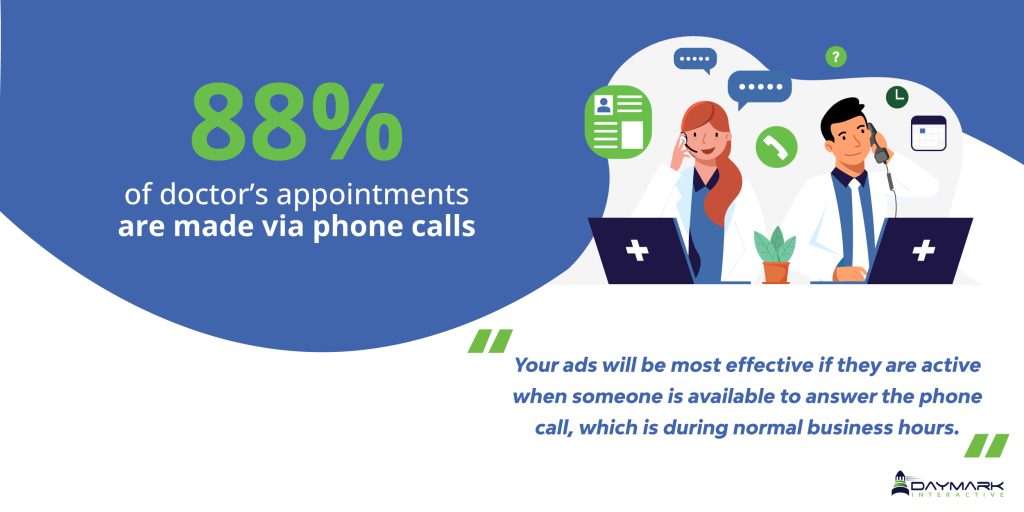
The common mistake that we observe from our clients is that all or a large portion of their daily PPC budget has been exhausted between the hours 12:00am – 8:00am, when visitors are not likely to call and no one is available to answer if they do.
If this is the case, once your staff is in the office and available to answer the calls to schedule appointments, there is very little budget remaining to reach these potential influx of new patients.
Have you ever performed a search for your ads after 12:00 pm and could not find them? This likely happens when your budget was used up at the wrong times.
Tips for Ad Scheduling
If you are running Google Ads for your healthcare organization, here are the recommended tips for ad scheduling:
- Run your ads when there is a person available to answer the calls. If you are using a call center that is 24/7, but they do not schedule the calls and transfer the caller to your local office, then limit your schedule accordingly. An answer by the call center, then a warm transfer to a voicemail system will not result in scheduled appointments.
- Consider adding lunch times to the ad schedule if your office does not have coverage or is closed during that time. Could only be 30 minutes, but it prevents wasted ad spend.
A major factor to successful healthcare PPC marketing is ensuring your ads appear at the times that they are most likely to result in a conversion (new patient) and optimizing your account for those times.
2. Use of Call Tracking Software
Most healthcare organizations are pushing to increase online appointment scheduling, but as stated above, 88% of appointments are still scheduled by phone.
With this in mind, in order to be successful, you must optimize for online appointments and phone calls by using tools such as call tracking software.
What is Call Tracking Software?
Call Tracking software is used by marketers to fill reporting gaps and track information from inbound phone calls back to the marketing campaign that prompted the calls.
One main feature that enables you to collect plenty of important information from callers is Dynamic Call Tracking. With this technology, a number is created for each source and medium and then displayed to each user based on the source and medium that they came through.
The dynamic call tracking then allows you to track phone calls back to the source, medium, and keyword used. It also provides you with information such as date and time of call, user location, channel conversion, etc.
There are a number of call tracking software platforms. Two of the more popular are CallTrackingMetrics and CallRail. They each have a lot of features and benefits, but the most important feature is the integration with Google Ads and Google analytics to pass conversion information.
Why Should Your Organization Use Call Tracking Software?
As they say, you cannot manage what you don’t measure.
By using call tracking software, you’re able to track and analyze important data, which then enables you to develop highly targeted marketing strategies. You’re able to optimize for what is working, but equally important is to stop what is not working.
With the phone call data separated by source and medium, you’re able to track your ad spend on each campaign, which enables you to calculate your average cost per conversion. This then helps you determine which better-performing campaigns you should increase your budget on.
| Example:
You have an Orthopedics campaign that focuses on joint replacements and another one that focuses on knee surgery and each spends $1,000 per month. If your call tracking software shows that the joint campaign had 20 calls for a cost per conversion of $50, while the knee campaign had 30 calls for a cost per conversion of $33, you should consider shifting ad spend in the following month to focus more on the knee campaign. |
![]()
Another reason you should use call tracking software is that it can attribute conversion data to calls from ad extensions. This is important as Google Analytics is not able to capture this, as the person never visited the site for the Google Analytics code to fire.
All of this is key when you are using some of the advanced bidding strategies in Google. You can measure the campaign’s effectiveness by phone calls and online conversions.
Using call tracking software is a critical component to healthcare PPC success that is often overlooked. Those that take the time to set up and integrate call tracking software will achieve significantly improved performance.
3. Continually Add Negative Keywords
Success in healthcare PPC marketing is partly about which keywords to target and writing compelling ad copy – it is also about diligently safeguarding your account from unnecessary ad spending.
While most of the focus is on how often we can make our ads appear, we need to also focus on when we do not want them to appear. This is where negative keywords are important.
What are Negative Keywords?
Negative keywords prevent your ads from appearing in irrelevant search queries by allowing you to add certain words and phrases as negative keywords to your ad group or campaign.

| Example:
You are running ads targeting the keyword “orthopedic surgeon” and your goal is for new patients to schedule an appointment. Then the following should be defined as negative keywords: jobs, careers, salaries, colleges, free, pictures, images, etc. |
In the example above where we are targeting the keyword “orthopedic surgeon”, a search query for “orthopedic surgeon salaries” or “best colleges for orthopedic surgeons” have different intent and will not result in a new patient appointment.
Why Should You Use Negative Keywords?
With the use of negative keywords, you’re avoiding wasted ad spend from irrelevant search queries that will not result in a phone call or online appointment or have very low conversion rates.
Consistently managing and updating negative keywords should have a tremendous impact on your account as it stops the waste and makes more ad spend available for the keywords that will convert.
The extra time spent focusing on building out the negative keyword list will be the difference between success and failure in your campaigns for months and years to come.
Tips for Using Negative Keywords
Each campaign should start with a negative keyword list that should continually be expanded by reviewing the search queries report. This is the report that shows you the actual queries that people have searched for that led to your ad appearing or being clicked.
There will be many negative keywords initially and should go down over time as your campaigns are continually optimized.
4. Avoid Too Many Broad Match Keywords
When setting up your healthcare PPC ad groups and campaigns, in addition to creating a list of keywords that you want to target, the next crucial step is for you to define the match type for those keywords.
Knowing how the keyword match types work and developing one of your healthcare PPC strategies around this will help you get the most out of your ad spend and attract more targeted traffic.
What are Keyword Match Types?
Keyword match types is the feature that gives you control over when your healthcare PPC ads should appear on Google and Bing based on how closely the search query matches your targeted keywords.
There are different keyword match types: Exact Match, Phrase Match, and Broad Match.
Exact match keywords are when you only want your ads to appear when the search query is exactly the same as the keywords you are targeting. If your keyword is “Knee doctor for arthritis”, then your ads will only appear when that exact search query is used.
Phrase match is when your targeted keywords need to be included in the search query, and in the order that you defined them, but there can also be other words in the search query. It still allows a lot of control, but also flexibility to catch queries that have not been directly targeted in your campaign.
Using the same example targeted keyword of “knee doctor for Arthritis,” with phrase match, your healthcare PPC ad would appear if the search query is “Best knee doctor for arthritis” or “knee doctor for arthritis near me.”
Broad match is when the search engines use their vast amount of data and match your targeted keywords with the search queries that they believe are most relevant. This is where the discovery of new keywords that can be added to the campaign can be found, but also a lot of waste can happen.
For broad match, using the same example of the targeted keyword “knee doctor for arthritis,” a broad match would cover the queries of “arthritis knee doctor,” “best arthritis doctor near me, and even would appear for “knee specialist for arthritis” or possibly even “rheumatoid arthritis doctor near me.’
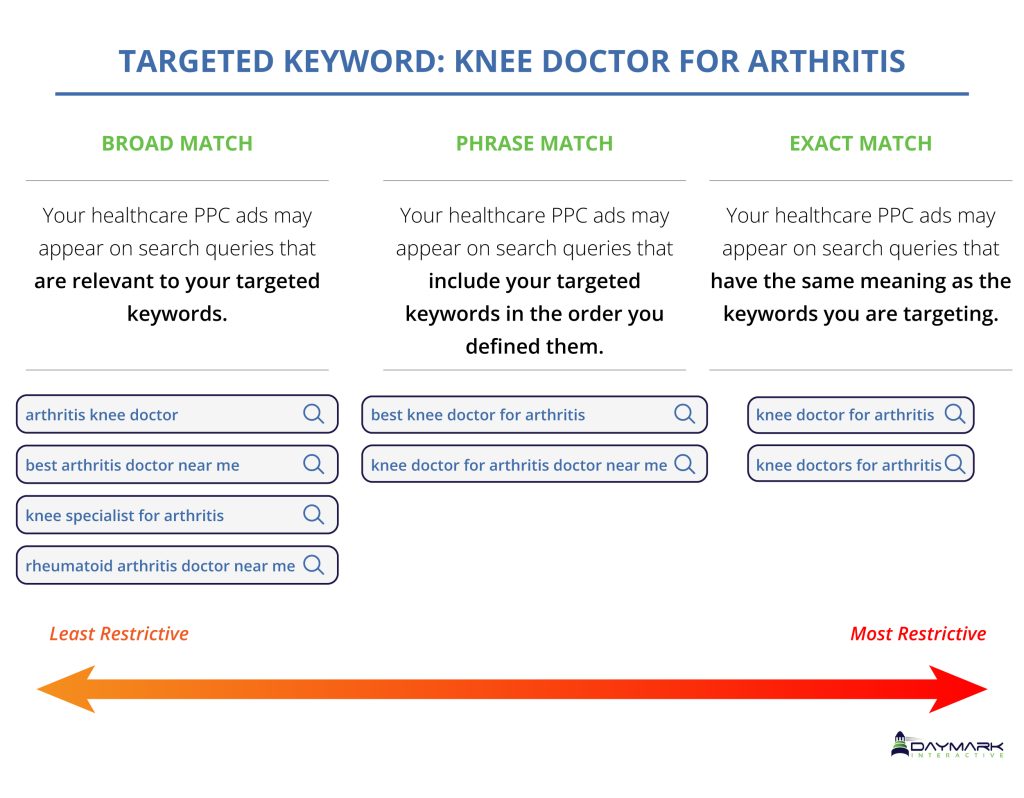
Why Should You Use Less Broad Match Keywords?
Broad match keywords typically have the most impressions but the lowest conversion rates. It’s primarily due to the lack of control over when the ads will appear and the uncertainty of the search queries that Google and Bing will associate with your keywords.
Building on the last section about negative keywords and combined with broad match, you can easily see how a lack of negative keywords and the use of too many broad match keywords can use your ad spend at a quick pace.
Tips for Using Keyword Match Types
One of the best PPC healthcare strategies is to include broad match keywords in your campaigns, but constantly monitor the search query reports to find the keywords that can be added as Phrase and Exact match to the campaign and which negative keywords need to be added.
Regularly updating your targeted keywords and negative keywords will improve the success of the broad match keywords in your campaigns.
5. Separate Branded Keywords
One huge mistake that is often made in healthcare PPC marketing is not separating the branded keywords from the non-branded keywords. This causes wasted ad spend and a higher cost per conversion than could be achieved.
What is the Difference Between Non-Branded and Branded Keywords?
If you are not familiar, a branded keyword is when the person searching already knows the name of your healthcare organization and uses it in the search query. Many times the persons who use branded terms are existing patients or patients through referrals. They are less likely to look for more information and are intent on making an appointment.
Meanwhile, the non-branded keyword is when the person uses generic terms that are related to your organization without your brand’s name. This could be the services that you offer.
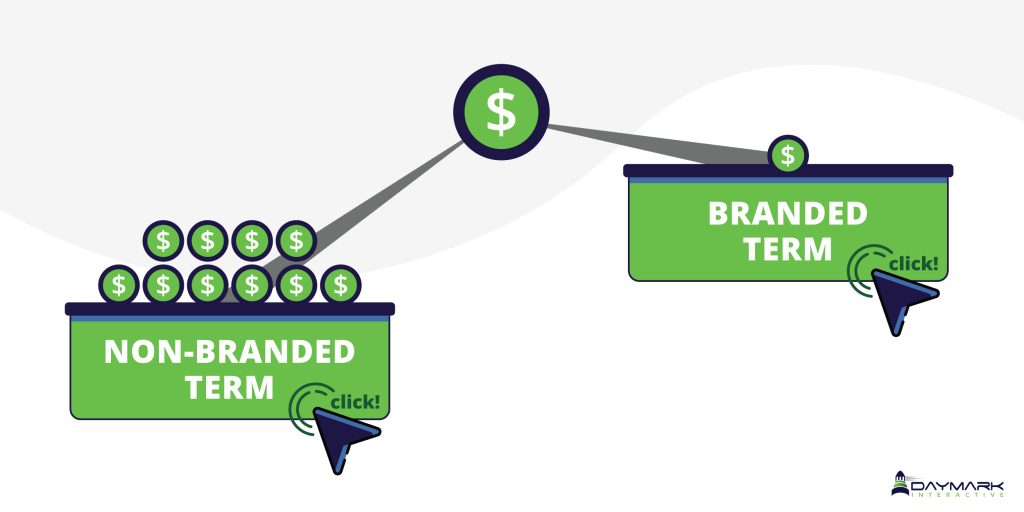
An example would be if the potential patient searches for the name of your healthcare organization, e.g. “XYZ orthopedic institute”. They are already familiar with the brand and are more likely to schedule an appointment than a person performing a general search like “Knee doctor for arthritis.”
Why Should You Separate Branded from Non-Branded Keywords?
The reasons that the branded and non-branded keywords should be separated are to lower bid costs, improve conversion rates, and reduce wasted ad spend.
Branded keywords are typically less competitive than generic terms, so you should bid much lower for the cost per click. Also, the conversion rate on branded terms will be much higher than non-branded terms.
| Example
The cost per click of a non-branded term ‘knee doctor for Arthritis’ is $4.00, while the cost per click of the branded term “XYZ orthopedic institute ”is $0.40. You should not have all of the keywords in the same campaign which will cause you to pay $4.00 for a click that you could have only paid $0.40. |
Separating the branded and non-branded keywords into different campaigns allows you to bid differently.
By keeping the keywords separate, you will also more clearly know which keywords are performing the best for brand and non-brand.
Tips for Using Branded Keywords
Once you have separated the branded keywords, add those same branded keywords as negative keywords on the non-branded campaigns. This way Google and Bing will not serve the more expensive keywords for the branded search queries.
This is fairly easy to implement but will be a tremendous cost savings and conversion improvement. By separating and spending less on branded queries, there is more budget available for the non-branded keywords that you are targeting.
What are the brand terms that you should separate from your main campaign into its own campaign?
6. Use Ad Extensions
One opportunity to beat your competitors is to include ad extensions with your ads that most have failed to add. Ad extensions are additional parts of the ad that you can use to improve the performance of your ads.
There are several types of ad extensions which include: locations, call extensions, callouts, sitelinks, and structured snippets. Each offers unique benefits and should be used when it makes sense.
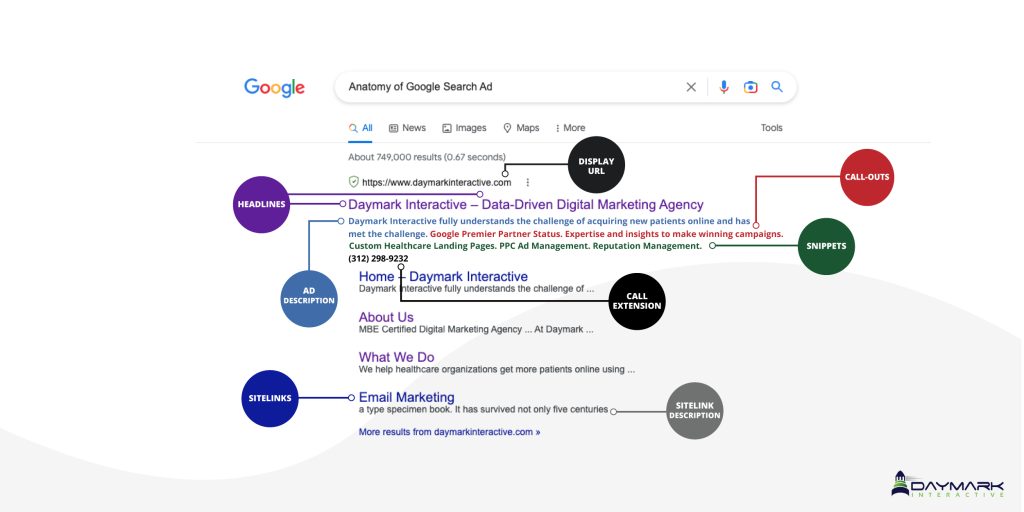
Why Should You Use Ad Extensions?
The biggest benefit of ad extensions is it increases the size of your ads which then improves your Click-through-rates. One of the major criteria that is used in ad performance is click-through-rate. The ads that have the better CTR’s will appear higher in the search results.
To state it another way, Google and Bing want to show the ads that people are clicking on. If people are not clicking on your ads, it is a bad user experience for the searcher and therefore not good for Google and Bing.
The use of ad extensions will immediately impact your ad performance and likely place your ad above your competitors. Take the time to get these added and reap the benefits that your competitors are not.
Conclusion
PPC for healthcare organizations can be very effective when managed and optimized correctly. It is not a “set it and forget it” medium and requires continual updates.
The big opportunity is that your competitors, or the agencies they hired, are not applying the level of detail needed for success. By applying the six optimizations laid out in this article will raise your account above 95% of your competitors that quickly.
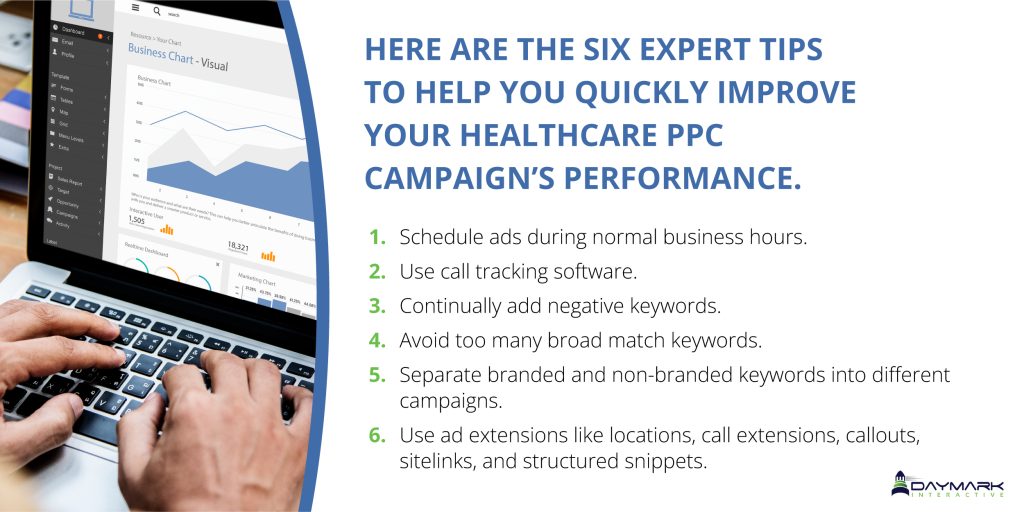
Implement these changes today and watch the dramatic improvement in your account.
Are you currently using all of the optimizations defined in this article? What other optimizations have led to success in your campaigns?

